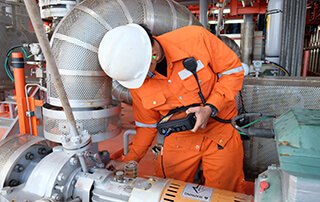Vibration measurement is used to diagnose problems and monitor stress on machines and equipment in many industries. Though a common measurement, the mounting, level of accuracy, and bandwidth required for vibration measurement makes it difficult to select the best measurement technology based on the equipment being monitored. Components such as velocity, acceleration, frequency, and displacement all play a part in vibration measurement – and some types of vibration sensors are designed to focus only on a single component. This makes understanding the function and design of different vibration sensors important when choosing which sensor type to use for your measurements.

Accelerometers, a type of vibration sensor that is used when in direct contact with the vibrating object, are the most common way of measuring vibration. Several types of accelerometers are popular for different reasons.
Piezoelectric accelerometers, the most popular type of accelerometer, are used for industrial applications. They have low noise, perform highly in most vibration and shock applications, and have variants (such as the charge mode PE accelerometer) that are designed to handle extreme environments. The most popular variant is the voltage mode IEPE accelerometer, which has a built-in charge amplifier. The biggest flaw of PE accelerometers is their inability to measure gravity or sustained accelerations.
Piezoresistive (PR) accelerometers are another kind of accelerometer that is commonly used when calculating velocity or displacement. They are the best option when measuring impulse and impact scenarios where the amplitude and frequency are high. PR accelerometers also tend to be expensive and more sensitive to temperature variation, so they aren’t commonly used for lower amplitude and frequency measurements.
Capacitive MEMS accelerometers are the smallest and lowest-cost type of accelerometer and are commonly used in smartphones. Although initially used in personal electronic devices for detecting movement, this type of accelerometer is now used in wireless vibration sensors for industrial applications.
Another type of contact vibration sensor is a strain gauge. This type of vibration sensor is not only versatile and attachable to any kind of surface, but is also accurate and lightweight. They are also relatively inexpensive on their own but require additional amplification devices that are more costly. Strain gauges are also difficult to install because they require full contact between the object being measured and the face of the gauge.
Gyroscopes, which are often used in conjunction with accelerometers, are useful at measuring angular rate. While accelerometers can sometimes become disoriented by scenarios with sustained static accelerations, a gyroscope can monitor the orientation of the system to create more accurate measurements.
There are also types of vibration amplitude sensors that don’t require contact. Microphones are a common type of non-contact vibration sensor that are cost-effective and easy to use. Displacement sensors are useful in situations where accelerometers are unusable, such as rotating objects or mass sensitive systems. There are also capacitive displacement sensors, which measure vibration through the air but are best used in a controlled environment such as a lab.
Like many other types of manufacturing sensors, vibration sensors have many different types with a variety of pros and cons. Understanding which scenarios these vibration sensors work best in will lead you to the one that will give you the most relevant and accurate measurements.
